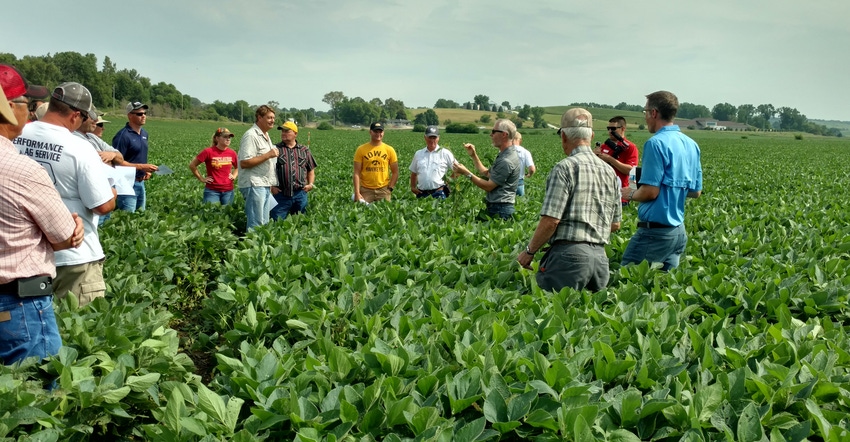February 1, 2019

Resistance continues to show up in weeds, insects and disease pathogens in Iowa fields, having the potential to reduce crop yields, increase cost of production and limit farmers’ future pest management options. Iowa has taken the lead on dealing with this issue by creating and implementing the Iowa Pest Resistance Management Program (IPRMP).
The intent of the program is to change the mindset of the entire ag community — farmers, landowners, agronomists, crop advisers, bankers, seed companies, chemical companies and research institutions — to include pest resistance management as a key part of crop-related decisions. Planning and rotation of practices and modes of action will help preserve the effectiveness of management tools.
A collaboration, consisting of farm organizations, commodity groups, the Iowa Department of Agriculture, Agribusiness Association of Iowa, Iowa State University Extension and others, began working together in 2015 to create the Iowa Pest Resistance Management Plan. The plan was launched in January 2017 and became a program with a statewide focus.
In May 2017, Evan Sivesind, an ISU integrated pest management specialist, became the program manager.
4 pilot projects in Iowa
“Because many pests are so mobile, resistance issues can easily spread farm to farm,” Sivesind says. “By working together, the agricultural community can quickly identify and address issues before they become difficult to control.”
The program established four pilot projects in 2017 to address pest issues that threaten crop productivity and profitability. These demonstrations in the fields of cooperators encourage other farmers to use resistance management practices to slow the development of pest adaptation to chemical, genetic and agronomic methods of control.
The demos include the following sites:
• In western Iowa, the Harrison County project is focusing on weed management. Specifically, it is zeroing in on Palmer amaranth, an invasive weed threat, along with evaluating practices for waterhemp, marestail and giant ragweed control.
• In northeast and north-central Iowa, the project is focusing on avoidance of Bt resistance in western corn rootworm. In 2018 Corteva Agriscience confirmed the first case of corn rootworm resistance to its Herculex Bt corn hybrid trait in a field in Delaware County.
• In northwest Iowa, the project is exploring identification and management of pyrethroid insecticide resistance in soybean aphid.
• In central Iowa, the Story County project is evaluating options for managing herbicide-resistant waterhemp.
Each pilot project is managed by a representative of a local team of farmers, crop consultants, fertilizer and chemical dealers, seed and chemical company representatives, lenders, ISU Extension personnel, and others in the ag community. The four teams share their knowledge, experience and the status of pest resistance in their area.
Sharing what they learn
“One of the functions of this program is outreach, to get the entire ag community to understand that pest resistance is here in Iowa, is getting worse, and we all need to be thinking of how to deal with it and prevent the problem from progressing,” says Larry Buss, a Harrison County farmer and team leader. “Farmers need to be aware of pest resistance problems as soon as they show up in their fields and need to take action to manage them. If we don’t do this, yields will decrease, or our costs will increase, or both.”
Buss serves on the Iowa Corn Promo-tions Board. Iowa Corn is one of the partner groups helping fund IPRMP. The Iowa Soybean Association also provides some funding, as does Iowa Farm Bureau and the seed and chemical industry.
In the Harrison County pilot, “we’ve been focusing on weeds,” Buss says. “Our team has decided we need to include crop diseases, too, so we will be providing crop disease education and management demonstrations in addition to weeds. None of the other three IPRMP pilot projects are focusing on disease management. However, crop diseases are increasingly becoming resistant to fungicides.”
Local teams drive projects
Farmers on the team help evaluate the cost-effectiveness of weed resistance management practices. “I’m extremely pleased how this project is evolving, the interest its receiving and especially how our team is working together,” Buss says. “The team is devoting time and energy to our project because they all feel, as I do, that we have to get on top of this resistance issue.”
Palmer amaranth was first discovered in Iowa in 2013 in Harrison County. This weed is of concern due to its competitiveness, fast growth rate, prolific seed production and ability to evolve resistance to herbicides. Once established in a field, Palmer amaranth drives weed management costs up significantly.
“Combating weed resistance requires a short-term and long-term focus and adaptive management as we learn what works and what doesn’t work,” Buss says.
Since it was first discovered in Iowa, Palmer has spread to other counties, in part because of contaminated grass seed brought into Iowa from Southern states to use for seeding Conservation Reserve Program acres. Some of the CRP seed mixes contained Palmer, and farmers who purchased the seed were unaware.
The other three weeds the Harrison County team is focusing on to improve management — waterhemp, giant ragweed and marestail — are widespread herbicide-resistant weeds in Iowa. Sharing the information learned in this project will help farmers statewide.
In Harrison County, growing conditions and management practices vary widely. “Our field demonstrations are taking place both in the Loess Hills and in the Missouri River Valley,” Buss says. “The viability of recommended resistance management practices is being tested and demonstrated in local cropping systems.”
“The local teams drive these projects,” Sivesind says. “Farmers, crop advisers and other ag professionals set the direction for each project and develop strategies to address the issues facing farmers in their area. The Harrison County project has a great team in place that understands the local landscape and the specific challenges farmers face.”
For more information, go online to protectiowacrops.org.
About the Author(s)
You May Also Like






